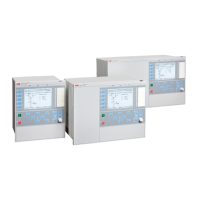6.3 Checking CT circuits
The CTs must be connected in accordance with the circuit diagram provided with
the IED, both with regards to phases and polarity. The following tests shall be
performed on every primary
CT connected to the IED:
• Primary injection test to verify the current ratio of the CT, the correct wiring
up to the protection IED and correct phase sequence connection (that is L1,
L2, L3.)
• Polarity check to prove that the predicted direction of secondary current flow
is correct for a given direction of primary current flow. This is an essential test
for the proper operation of the differential function.
• CT secondary loop resistance measurement to confirm that the current
transformer secondary loop dc resistance is within specification and that there
are no high resistance joints in the CT winding or wiring.
• CT excitation test in order to confirm that the current transformer is of the
correct accuracy rating and that there are no shorted turns in the current
transformer windings. Manufacturer's design curves should be available for the
current transformer to compare the actual results.
• Earthing check of the individual CT secondary circuits to verify that each three-
phase set of main CTs is properly connected to the station earth and only at
one electrical point.
• Insulation resistance check.
• Phase identification of CT shall be made.
Both primary and secondary sides must be disconnected from the
line and IED when plotting the excitation characteristics.
If the CT secondary circuit earth connection is removed without the
current transformer primary being de-energized, dangerous voltages
may result in the secondary CT circuits.
6.4 Checking the power supply
Check that the auxiliary supply voltage remains within the permissible input
voltage range under all operating conditions. Check that the polarity is correct
before powering the IED.
6.5
Checking the binary I/O circuits
Section 6 1MRK 504 088-UEN C
Checking the external optical and electrical connections
74
Installation and commissioning manual

